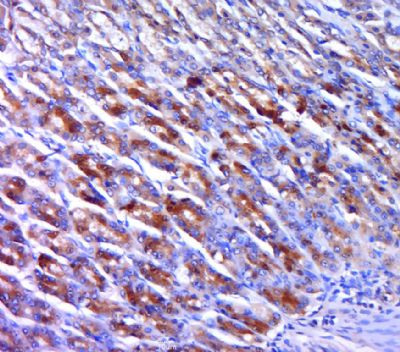UEVLD Polyclonal Antibody
Purified Rabbit Polyclonal Antibody (Pab)
- SPECIFICATION
- CITATIONS
- PROTOCOLS
- BACKGROUND

Application
| WB, IHC-P, IHC-F, IF, E |
|---|---|
| Primary Accession | Q8IX04 |
| Reactivity | Rat, Pig, Dog, Bovine |
| Host | Rabbit |
| Clonality | Polyclonal |
| Calculated MW | 52 KDa |
| Physical State | Liquid |
| Immunogen | KLH conjugated synthetic peptide derived from human UEVLD |
| Epitope Specificity | 85-180/471 |
| Isotype | IgG |
| Purity | affinity purified by Protein A |
| Buffer | 0.01M TBS (pH7.4) with 1% BSA, 0.02% Proclin300 and 50% Glycerol. |
| SIMILARITY | In the N-terminal section; belongs to the ubiquitin-conjugating enzyme family. UEV subfamily.In the C-terminal section; belongs to the LDH/MDH superfamily.Contains 1 UEV (ubiquitin E2 variant) domain. |
| SUBUNIT | Homodimer. |
| Important Note | This product as supplied is intended for research use only, not for use in human, therapeutic or diagnostic applications. |
| Background Descriptions | UEV3, also known as EV and lactate/malate dehydrogenase domain-containing protein, is a 471 amino acid protein that contains one UEV (ubiquitin E2 variant) domain, which typically interacts with ubiquitin. UEV3 is thought to be a paralogue of tsg 101, a protein that exerts regulatory effects on E2 activity in cellular ubiquitination processes. With amino-terminal homology to the catalytic domain of ubiquitin-conjugating enzymes, it is thought that UEV3 may function as a negative regulator of polyubiquitination. UEV3 is expressed in various colon carcinoma cell lines, carcinomas of the uterine cervix and peripheral blood leukocytes as well as normal colon and cervical epithelium. |
| Gene ID | 55293 |
|---|---|
| Other Names | Ubiquitin-conjugating enzyme E2 variant 3, UEV-3, EV and lactate/malate dehydrogenase domain-containing protein, UEVLD {ECO:0000312|EMBL:AAH64566.1} |
| Target/Specificity | Colon, colon carcinoma cell lines, normal cervical epithelium, carcinomas of the uterine cervix and peripheral blood leukocytes. |
| Dilution | WB=1:500-2000,IHC-P=1:100-500,IHC-F=1:100-500,IF=1:100-500,ELISA=1:5000-10000 |
| Storage | Store at -20 ℃ for one year. Avoid repeated freeze/thaw cycles. When reconstituted in sterile pH 7.4 0.01M PBS or diluent of antibody the antibody is stable for at least two weeks at 2-4 ℃. |
| Name | UEVLD {ECO:0000312|EMBL:AAH64566.1} |
|---|---|
| Function | Possible negative regulator of polyubiquitination. |
| Tissue Location | Colon, colon carcinoma cell lines, normal cervical epithelium, carcinomas of the uterine cervix and peripheral blood leukocytes. |

Thousands of laboratories across the world have published research that depended on the performance of antibodies from Abcepta to advance their research. Check out links to articles that cite our products in major peer-reviewed journals, organized by research category.
info@abcepta.com, and receive a free "I Love Antibodies" mug.
Provided below are standard protocols that you may find useful for product applications.
If you have used an Abcepta product and would like to share how it has performed, please click on the "Submit Review" button and provide the requested information. Our staff will examine and post your review and contact you if needed.
If you have any additional inquiries please email technical services at tech@abcepta.com.













 Foundational characteristics of cancer include proliferation, angiogenesis, migration, evasion of apoptosis, and cellular immortality. Find key markers for these cellular processes and antibodies to detect them.
Foundational characteristics of cancer include proliferation, angiogenesis, migration, evasion of apoptosis, and cellular immortality. Find key markers for these cellular processes and antibodies to detect them. The SUMOplot™ Analysis Program predicts and scores sumoylation sites in your protein. SUMOylation is a post-translational modification involved in various cellular processes, such as nuclear-cytosolic transport, transcriptional regulation, apoptosis, protein stability, response to stress, and progression through the cell cycle.
The SUMOplot™ Analysis Program predicts and scores sumoylation sites in your protein. SUMOylation is a post-translational modification involved in various cellular processes, such as nuclear-cytosolic transport, transcriptional regulation, apoptosis, protein stability, response to stress, and progression through the cell cycle. The Autophagy Receptor Motif Plotter predicts and scores autophagy receptor binding sites in your protein. Identifying proteins connected to this pathway is critical to understanding the role of autophagy in physiological as well as pathological processes such as development, differentiation, neurodegenerative diseases, stress, infection, and cancer.
The Autophagy Receptor Motif Plotter predicts and scores autophagy receptor binding sites in your protein. Identifying proteins connected to this pathway is critical to understanding the role of autophagy in physiological as well as pathological processes such as development, differentiation, neurodegenerative diseases, stress, infection, and cancer.


